【业务架构】TOGAF建模:组织分解图(组织映射)
组织分解图描述了组织树中参与者、角色和位置之间的链接。组织图应该提供组织中所有者和决策者的指挥链。虽然组织分解图的目的不是将目标与组织联系起来,但是应该可以从组织分解图直观地将目标与涉众联系起来。
这个图表还可以描述参与者的定义和他们的职责。组织是指参与者之间的联系,或者是参与者和组织单位之间的联系,表现出等级关系、沟通和责任。
通过展示企业主要参与者之间的主要信息流,还可以突出组织内的任务和责任。这显示了组织中由谁接收、处理或发出哪些信息,从而说明了组织元素的责任。
组织分解图还用于定义参与者承担的不同角色。
位置、角色和参与者
在图1所示的示例中,表示了位置、角色和参与者。总部设在巴黎,在南特、图卢兹和里昂有三家分公司。组织单位已分配到不同的地点。大部分服务集中在巴黎。IT部门设在图卢兹。每个分支机构都有销售部。通过其职责链接(角色到角色或组织单元),角色的地理位置通常是隐含的。
UML/BPMN EAP Profile
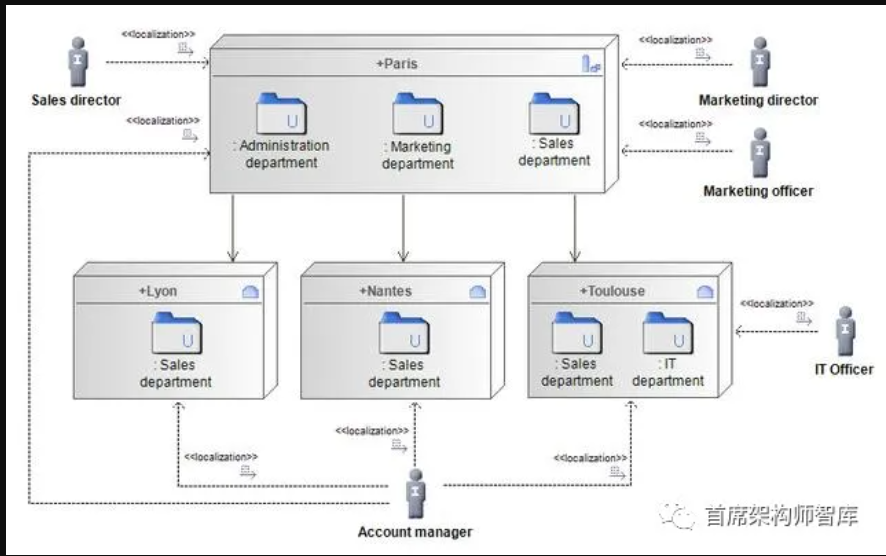
Figure 1 - Roles, actors, locations and organization units are represented in organization decomposition diagrams
Show/Hide legend
- Internal actor: An actor that belongs to the enterprise.
- Headquarter location: Geographically defines where the elements of the enterprise are deployed (organization units, hardware devices, actors, etc).
- Site location: Geographically defines where the elements of the enterprise are deployed (organization units, hardware devices, actors, etc). Generally, an enterprise has one headquarter and several sites.
- Organization unit: Describes one unit that breaks down the organization of the enterprise. This can be, for example, a department.
- Localization link: Localization link of an element of an enterprise (actor, business unit, hardware device, etc) in a location. Alternatively, the localized element can be embedded into the location.
Archimate
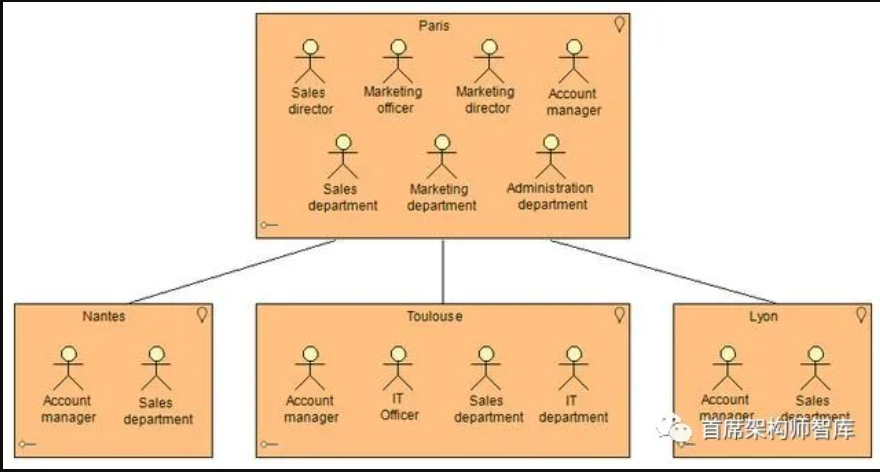
角色及其职责的定义
如图2所示,角色及其职责的定义是以一般方式展示企业功能的一种好方法。企业的参与者及其交互提供了对组织的概述。
一个企业内的几个演员可以代表几个人。某些演员代表一群人或演员,例如“董事会”:这是一个将不同部门的董事聚集在一起的例子。但和其他演员一样,它也有责任和决策权。
企业外部的参与者有助于展示他们对组织本身的定位:谁与他们互动。
存在的元素:
- 描述层级的责任链接
- 责任链接到组织单位,表明谁负责哪个组织单位
- 沟通链接,表明谁与谁沟通
- 构图环节,展示复合演员的构成。
- 内部行动者,即参与企业运作的行动者
- 外部参与者,他们是企业外部的参与者,但与企业互动(此处:客户和合作伙伴)
UML/BPMN EAP Profile

Figure 2 - This model provides the organization chart, enriched by information on responsibilities and communication
Show/Hide legend
- Organization unit: Describes one unit that breaks down the organization of the enterprise. This can be, for example, a department.
- Internal actor: An actor that belongs to the enterprise.
- External actor: An actor that is external to the enterprise.
- Communicates with link: Indicates that two roles or actors communicate together to realize their work.
- Composed of link: Indicates that a role is composite, and is made up of other roles.
- Responsible for link: Indicates hierarchical responsibilities between roles or actors, and responsibilities of organization units.
Archimate

Figure 2 - This model provides the organization chart, enriched by information on responsibilities and communication
- Business Actor.
- Meaning.
企业内部流通的主要信息流
图3显示了在企业内部流通的主要信息流。它们是从行动者和/或组织单位接收或发送给它们的。此示例集中于从外部参与者发出/发送到外部参与者的流,以及参与处理的主要组织单元。
UML/BPMN EAP Profile
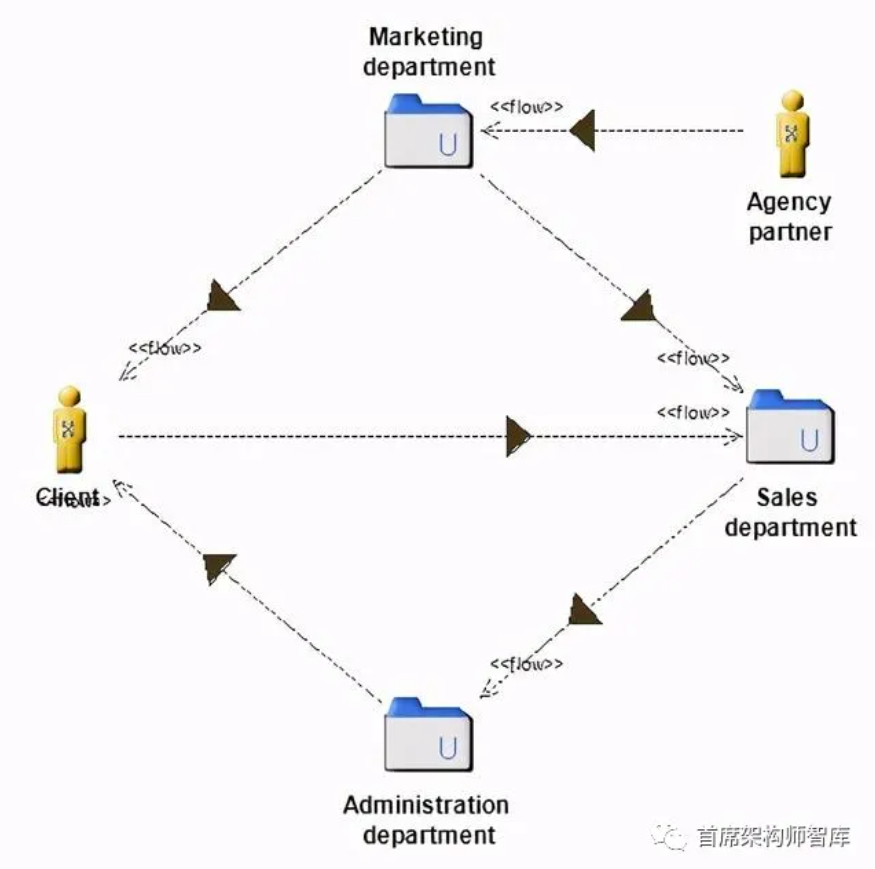
Figure 3 - Main information flows within the enterprise
Elements used:
• Actors
• Business Units
• Information flows: Information can be related to business entities to express that these are the exchanged data (Bill and Order in this example).
Show/Hide legend
- Organization unit: Describes one unit that breaks down the organization of the enterprise. This can be, for example, a department.
- External actor: An actor that is external to the enterprise.
- Information flow: Defines the flow of any kind of information (business entity, event, product, informal, etc) between active entities of the enterprise.
Archimate
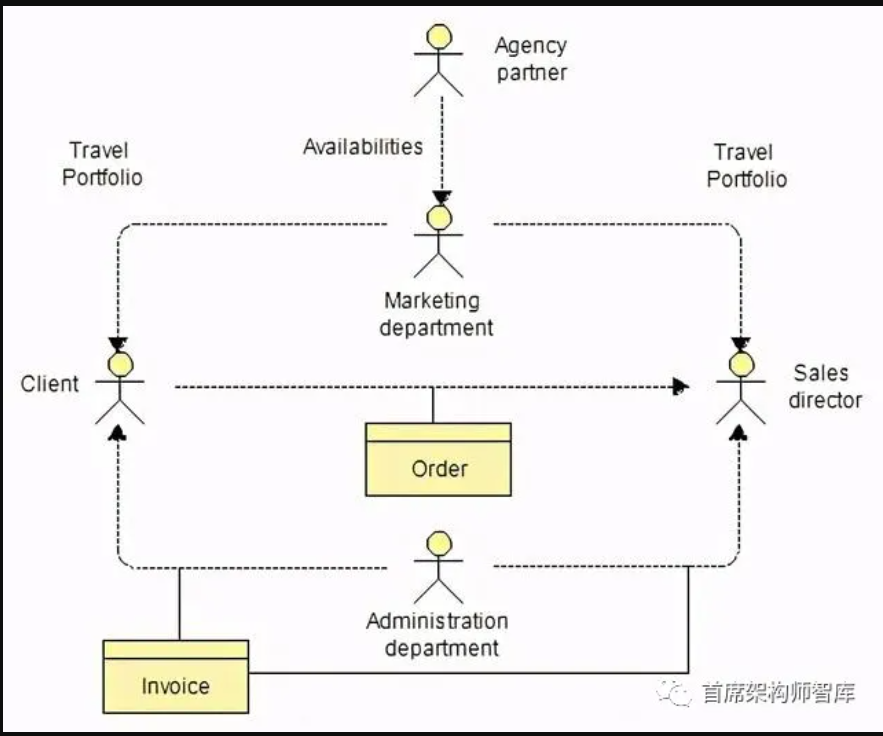
Figure 3 - Main information flows within the enterprise
Show/Hide legend
- Business Actor.
- Business Object.
- Flow.
参与者承担的角色
图4显示了由参与者承担的角色。演员扮演一个角色来执行任务。演员通常或预期的功能,或某人或某物在某一特定动作或事件中所扮演的角色,在这里进行了建模。
UML/BPMN EAP Profile
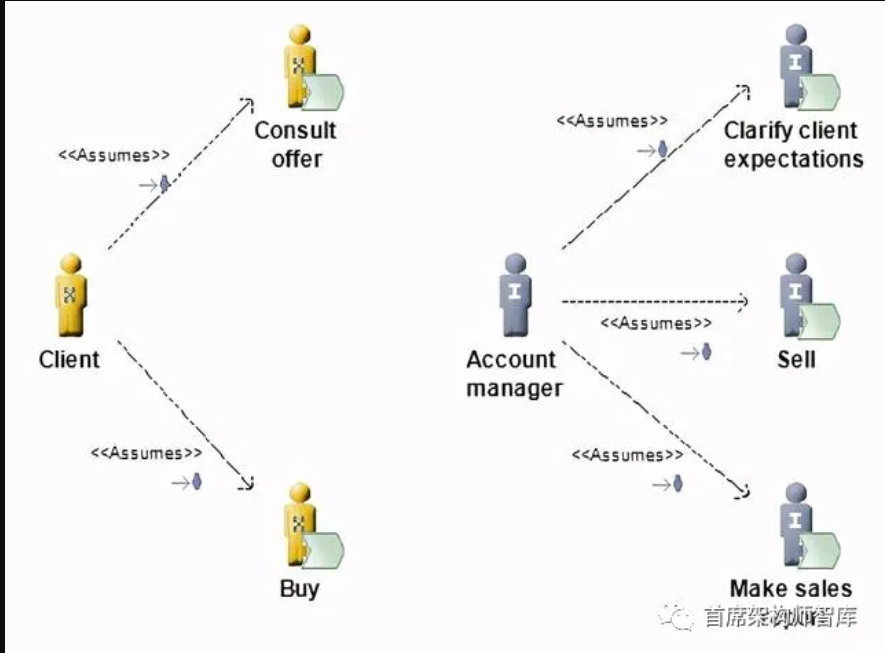
Figure 4 - Roles assumed by actors
Elements used:
• Actors
• Roles
• "assumes" dependencies
Show/Hide legend
- Internal actor: An actor that belongs to the enterprise.
- External actor: An actor that is external to the enterprise.
- Internal role: Role played by an internal actor during a given action (task).
- External role: Role played by an external actor during a given action (task).
Archimate
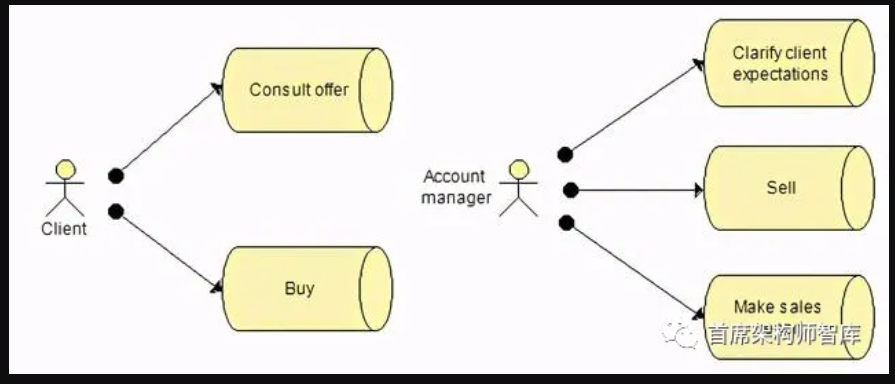
Figure 4 - Roles assumed by actors
Show/Hide legend
- Business Actor.
- Business Role.
- Assignment.
详细参与者承担的角色
图5显示了相同类型的模型,但是显示了一个非常详细的层次,集中在一个参与者上。这种每个参与者的详细模型提供了每个参与者的详细定义,显示了其任务、责任和权利。此图显示了分配给销售总监的目标、他/她的职责(业务部门、管理的参与者)、他/她拥有的业务流程、他/她的位置、假定的角色、他/她使用的应用程序组件、他/她与之交互的其他参与者,以及他/她有权访问的企业实体。
UML/BPMN EAP Profile

Figure 5 - Detailed model of actors, focused on Sales director
Show/Hide legend
- Goal: This is a goal or objective of the enterprise.
- Internal actor: An actor that belongs to the enterprise.
- Headquarter location: Geographically defines where the elements of the enterprise are deployed (organization units, hardware devices, actors, etc).
- Organization unit: Describes one unit that breaks down the organization of the enterprise. This can be, for example, a department.
- Business macro process.
- Composed of link: Indicates that a role is composite, and is made up of other roles.
- Responsible of link: Indicates hierarchical responsibilities between roles or actors, and responsibilities of organization units.
- Owner of link.
- Assigned link: Assignment of a goal to an element of the enterprise, typically an actor, an organization unit or a business process.
- Localization link: Localization link of an element of an enterprise (actor, business unit, hardware device, etc) in a location. Alternatively, the localized element can be embedded into the location.
Archimate

Figure 5 - Detailed model of actors, focused on Sales director
Show/Hide legend
- Business Actor.
- Location.
- Business Process.
- Assignment link.
- Influence link.
- Goal.
- Association link.
- Aggregation link.
讨论:请加入知识星球【首席架构师圈】或者小号【ca_cea】或者QQ群【11107777】
- 217 次浏览